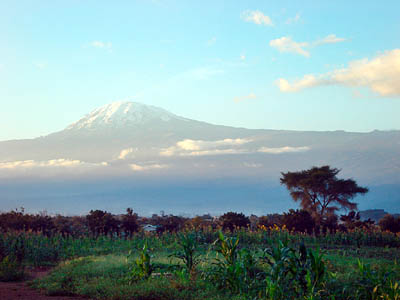
Kilimanjaro. Photo: Marc van der Chijs
Kilimanjaro, recently summited by a constellation of British stars, is one of the most dangerous mountains in the world.
When the group of celebrities this week huffed and puffed their way to the top of Africa’s highest peak, they were tackling a route fraught with lethal risks, according to a top mountain expert. The cold, dehydration and altitude cause between 50 and 75 per cent of would-be summiteers to turn back, according to Dr Jeremy Windsor, a member of the medical commission of the world’s mountaineering body.
Dr Windsor, a UK member of the commission advising the Union Internationale des Associations d’Alpinisme, has produced a guide to staying fit and healthy on the 5,892m (19,330ft) mountain in Tanzania.
Cheryl Cole, Fearne Cotton, Denise van Outen, Kimberley Walsh, Alesha Dixon, Ronan Keating, Ben Shephard and Chris Moyles all got to the top of Kili to raise cash for Comic Relief. Many of the mountain’s 40,000 visitors annually are not so lucky.
The key to success when aiming for the top of the dormant volcano is allowing time for acclimatisation, according to Dr Windsor, who wrote the paper with Dr George Rodway of the University of Utah in the USA.
“Strange as it may sound, Kilimanjaro is perhaps one of the most dangerous mountains in the world,” Dr Windsor says. “Despite reliable weather and straightforward access, illness and injury are commonplace.”
An exacerbating factor is that Tanzanian authorities charge a daily fee for anyone on the mountain, leading to a tendency to rush the ascent and risk problems of acute mountain sickness.
Alarmingly, among the dangers cited in Dr Windsor’s paper is electrocution – the standards of electrical installations in Tanzania’s hotels are not the best. “Electrical connections and wiring in hotels should be treated with the utmost caution,” he says. It would be a shame if, having forked out for the chance of a crack at the continent’s top peak, a bit of dodgy wiring stymied your effort.
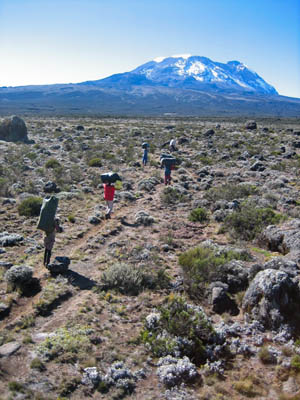
Trekkers to Kilimanjaro face a range of hazards. Photo: telethon
Other perils the African mountaineer has to consider are less obvious. HIV-Aids is endemic in the area, with 6½ per cent of Tanzania’s adult population estimated to have the virus. The medic’s recommendation is: “Use barrier contraception, or better still, refrain from sexual contact altogether.” One visitor interviewed for the paper went further: “If not with your regular partner, the only form of safe sex in sub-Sahara Africa is on your own, under a mosquito net, wearing a condom and some would add also wearing rubber gloves.”
Death in a road accident is the most common cause of demise for western visitors. Crowded buses and taxis are best avoided.
Malaria, cholera and rift valley fever are all concerns the Kilimanjaro-goer should consider, with a pre-trip anti-malarial course essential. The nasty parasite that causes Bilharzias lurks in water sources although treatment is relatively simple.
If the summiteer manages to survive all the rigours of everyday life in Tanzania and starts the trek up the mountain, one of the first concerns will be hygiene.
Our heroic celebs complained of each other’s stench by the time they reached the summit, but keeping clean is a real concern. One interviewee recommends ditching extra clothing to accommodate a thicker sleeping bag to cope with the cold on the mountain.
But the sheer number of visitors, which will no doubt be swelled following the exploits of Cole and colleagues, is causing problems on the mountain. One travel company reported 12 times the number of enquiries for Kili during the first two weeks of this month. Dr Windsor says: “Poor management of human waste, large numbers of visitors and the limited availability of water mean that there is a real risk of acquiring a viral or bacterial infection on the mountain.
“Despite this, the local kitchen teams are often magnificent and maintain an extraordinary level of cleanliness in difficult circumstances. In return we owe it to them to maintain a high standard of personal hygiene ourselves. Regular handwashing with anti-bacterial soap is vital!”
Unlike the Red Nosers, it is unlikely that the average Kili trekker will be accompanied by 120 porters, 32 production staff and a team of doctors. Similarly, don’t expect one of your pals to hire a private jet to get you home for £50,000!
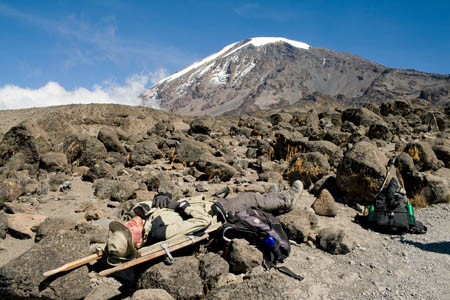
A stretcher will be needed for anyone unable to walk. Photo: Stig Nygaard
In fact, airborne evacuation is a non-starter on the mountain. The report says: “Unfortunately a helicopter rescue is not an option on Kili! For those who can’t walk, the only alternative is the portable stretcher. In experienced hands these devices are lifesavers and can ferry the sick and injured to the park gates very quickly.”
However, Dr Windsor says the Tanzanian mountain guides are knowledgeable, attentive and strong.
“If you’re able to walk they can get you off the mountain safely. Many have been trained in the diagnosis and treatment of life-threatening conditions such as HAPE [high-altitude pulmonary oedema] and HACE [high-altitude cerebral oedema].
“Importantly, they all know the importance of the mantra ‘descend, descend, descend’ in these situations! Most trekking companies carry a cylinder of supplemental oxygen or a portable hyperbaric chamber for those suffering from HAPE or HACE.
“Fortunately, Kili’s steep ascent profile and good paths make it possible to descend quickly. HAPE and HACE victims often improve quickly. Sometimes just a few hundred metres of descent is enough to reverse the effects of altitude.
“Many, diagnosed with life-threatening conditions, reach the park gates eager to climb again!”
The advice for anyone organising a rescue is to make sure that the victim is accompanied by at least two people – one to guide and carry equipment and a second who can go for help in case there are difficulties. Encourage them to use trekking poles, especially if they’re slow and unsteady – they can make life a lot easier, Dr Windsor says.
The Tanzanian guides are as prone to acute mountain sickness as the trekkers. Unlike the Himalayan Sherpas, they live their everyday lives at low altitude and so do not build up the acclimatisation that will protect them. “As employers and human beings, trekkers have a responsibility to treat their guides and porters as they would want to be treated themselves,” he points out.
Dr Windsor recommends taking the same route as the Red Nosers, via the Lemosho Glades. This, he says, allows an ascent profile that allows acclimatisation, as well as offering a range of stunning habitats to walk through.
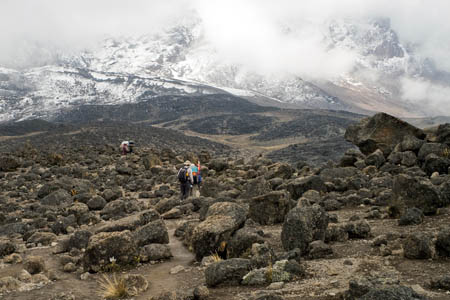
Approaching the Lava Tower. Photo: Stig Nygaard
Big Tree Camp – Mti Mikubwa – is reached through tree cover on a gentle incline. Sun hat, sunblock and lots of water are essential. Blisters are a possibility not just on the feet but on hands unaccustomed to prolonged walking-pole use.
By Shira Camp 1, at 3,350m (10,991ft), altitude problems may start. He points out that the younger, fitter members of any party are likely to be most at risk because they have raced ahead at a less sustainable pace.
Expect broken sleep, as altitude causes problems with breathing and an increased need to urinate! Headaches are also common. Swollen faces in the morning are also often seen as mild oedema sets in.
The Barranco Wall can cause big difficulties for anyone suffering from altitude problems, though for everyone else, it is safe. The medic says it is here you will encounter the panting members of parties who have taken the shorter routes, and are suffering because of it.
A final day spent at Barafu Camp, 4,600m (15,092ft) high, and rest is needed for the typical midnight start for the summit push.
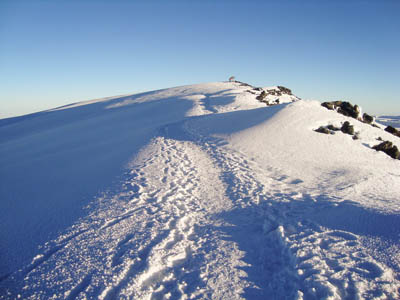
Kili's summit. Photo: Marc van der Chijs
The summit is usually achieved after a slog of about six to eight hours and is invariably described as the hardest day.
Once the sun goes down anywhere on the mountain, tee-shirts will need to be swapped with down jackets and mountain trousers as the temperature plummets to -20C. Without a full-length inflatable mattress, you won’t get much sleep in the sub-zero temperatures.
Other essentials on Kili are warm boots, gaiters to stop the snow going down them and two pairs of socks to keep your feet dry. A waterproof jacket is needed to keep you dry as you drop down below cloud level and a water bottle you can slip inside you clothing will help stop it freezing.
It’s not a technical climb, with only easy scrambling on the Barranco Wall, so leave your ropes, harnesses and helmet at home.
However, do go prepared for a wide range of temperatures, from the already mentioned minus 20C to a sweltering 30C at times.
And, following the publicity surrounding the Comic Relief ascent, expect to encounter crowds on the paths to the summit.
Dr Windsor’s advice can be found on the UIAA website.
Denzil Broadhurst
16 March 2009And don't forget for more general recommendations for travel at high altitude the free downloadable booklet (supported by UIAA) from Medex at www.medex.org.uk
Daniel
01 May 2009Interesting article. Do you know where they got these failure rates? I can see how they might be accurate for the "Tourist" or Marangu route. But that seems very high for Machame or Rongai.
sarah
26 July 2009my mum is walkng up this moutan now and i didnt realise the dangers until know and now i wish she hadn't left and was back home with me and by 9 year old brother but im sure she will get up the mountain and she will come home to us.
Homepage
22 February 2012... [Trackback]...
[...] Informations on that Topic: grough.co.uk/magazine/2009/03/15/kilimanjaro-dangers-galore-on-the-summit-trail [...]...
Homepage
01 August 2012... [Trackback]...
[...] Read More here: grough.co.uk/magazine/2009/03/15/kilimanjaro-dangers-galore-on-the-summit-trail [...]...
electronic cigarette
05 May 2013electronic cigarette...
So far, I can respire wagerer, my good sense for the harshest personal effects to go out....
sensor technology
24 June 2014howdy! , I like your producing consequently a whole lot! promote all of us communicate much more about this post upon Yahoo? I want a professional on this living space in order to unravel my personal difficulty. Might be that is people! Looking to help you.
click to see more
20 November 2014looking for somewhere cheap to stay for I night on the 15.4 10 two adutls and two children under 10 thank you
reliable pharmacy documentation printing
17 January 2015YES Print has for over two decades, been delivering most reliable solutions for ISF Dividers delivering to the leading Clinical Research Organisations crossing five different continents.
Click Here
01 March 2015jasa Pembuatan website bandung says: January 25, 2015 at 9:15 amI know this web page offers quality depending articles and other information, is there any other website which presents these data in quality? jasa Pembuatan website bandung recently posted..jasa Pembuatan website bandungReply